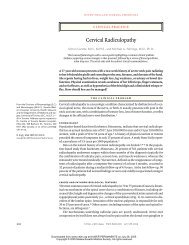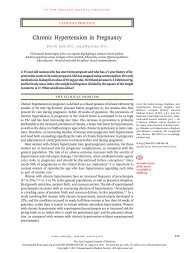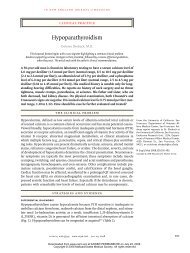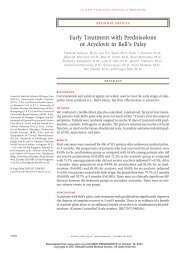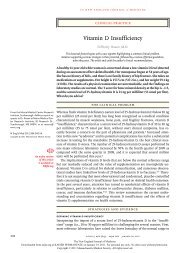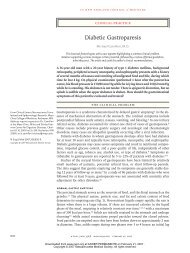Contrast-induced nephropathy: How it develops, how to prevent it
Contrast-induced nephropathy: How it develops, how to prevent it
Contrast-induced nephropathy: How it develops, how to prevent it
You also want an ePaper? Increase the reach of your titles
YUMPU automatically turns print PDFs into web optimized ePapers that Google loves.
CONTRAST-INDUCED NEPHROPATHY<br />
RUDNICK AND COLLEAGUES<br />
<strong>Contrast</strong> agents<br />
Ionic<br />
MONOMERS<br />
DIMERS<br />
I I I I I I<br />
I<br />
COO – Na + - - -R- - -<br />
COO – Na +<br />
Iothalamate *<br />
Ioxaglate †<br />
Diatrizoate *<br />
I<br />
I<br />
Metrizoate *<br />
Nonionic<br />
I I I I I I<br />
I<br />
- - -R- - -<br />
Iohexol †<br />
Iodixanol ‡<br />
Ioversol †<br />
I<br />
I<br />
Ioparnidol †<br />
*High-osmolar agents<br />
†Low-osmolar agents<br />
‡Iso-osmolar agent<br />
ADAPTED FROM RUDNICK MR. THE ROLE OF OSMOLALITY IN CONTRAST-ASSOCIATED NEPHROTOXICITY. APPLICATIONS IN IMAGING—<br />
CARDIAC INTERVENTIONS. SCOTCH PLAINS, NY: ANDERSON PUBLISHING, 2003.<br />
The newest<br />
contrast agent<br />
is a nonionic<br />
dimer and is<br />
iso-osmolar<br />
FIGURE 1<br />
Moreover, an enormous number of<br />
patients receive contrast agents. For example,<br />
in 2000, approximately 1,318,000 diagnostic<br />
cardiac catheterizations and 561,000 percutaneous<br />
transluminal coronary angioplasty procedures<br />
were performed, which are just two of<br />
the many procedures in which contrast is<br />
used. 2<br />
■ TYPES OF CONTRAST MEDIA<br />
The earliest contrast agents were ionic, containing<br />
a sodium a<strong>to</strong>m that dissociated from<br />
the molecule in aqueous solution. Each molecule<br />
of the agent carried three iodine a<strong>to</strong>ms.<br />
Therefore, these agents required two osmotically<br />
active particles <strong>to</strong> deliver three iodine<br />
a<strong>to</strong>ms, and they had extremely high osmolal<strong>it</strong>ies<br />
(about 2,000 mOsm/L). These agents,<br />
termed high-osmolar or ionic, were the predominant<br />
ones used until the 1980s (FIGURE 1).<br />
The next generation, introduced in the<br />
1980s and still the predominant contrast<br />
media in use, are nonionic. 3 Since they therefore<br />
need only one osmotically active particle<br />
<strong>to</strong> deliver three iodine a<strong>to</strong>ms, their osmolal<strong>it</strong>y<br />
is only about 600 <strong>to</strong> 900 mOsm/L, and they<br />
are termed low-osmolar.<br />
Both types of agents are monomers, w<strong>it</strong>h<br />
one benzene ring and three iodine a<strong>to</strong>ms.<br />
Dimer molecules consisting of two joined benzene<br />
rings contain a <strong>to</strong>tal of six iodine a<strong>to</strong>ms<br />
per molecule. There is one ionic dimer,<br />
ioxaglate, which has a 6:2 or 3:1 ratio of<br />
iodine a<strong>to</strong>ms <strong>to</strong> osmotically active particles<br />
and has an osmolal<strong>it</strong>y of 600 mOsm/L, similar<br />
<strong>to</strong> other low-osmolar contrast agents.<br />
The newest contrast agent, iodixanol, is a<br />
nonionic dimer. The chemical structure of this<br />
agent allows six iodine a<strong>to</strong>ms <strong>to</strong> be attached <strong>to</strong><br />
one osmotically active particle, resulting in an<br />
osmolal<strong>it</strong>y of 300 mOsm/L, which is iso-osmolar<br />
w<strong>it</strong>h normal plasma.<br />
■ DOES CONTRAST NEPHROPATHY<br />
INCREASE MORTALITY?<br />
Patients undergoing percutaneous coronary<br />
interventions have a higher mortal<strong>it</strong>y rate if<br />
<strong>nephropathy</strong> <strong>develops</strong>. 4,5 The risk of dying is<br />
greatest in patients who require dialytic support<br />
because of the <strong>nephropathy</strong>. For example,<br />
76 CLEVELAND CLINIC JOURNAL OF MEDICINE VOLUME 73 • NUMBER 1 JANUARY 2006






